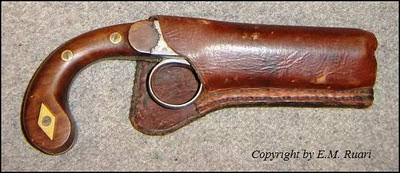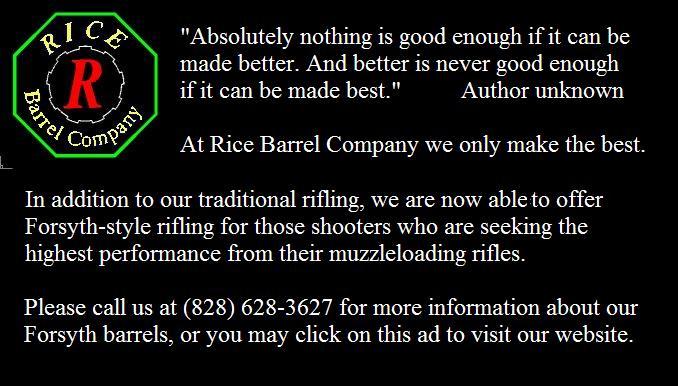By now you readers should understand that we really appreciate the KISS principle when it comes to engineering firearms. For those who are not familiar with the KISS principle, the acronym means Keep It Simple, Stupid.
Anyone can take a good design and complicate the hell out of it. The resulting Rube Goldberg gadget will usually amaze and baffle a simple mind. However, it takes real genius to accomplish something in the simplest manner with the least motion and the least number of parts. This latter approach gains the most accolades from engineering and machine heads.
Recently a reader sent an e-mail and shared the pistol seen below. Because it is Simplicity exemplified, and in such wonderful condition, I was eager to share it with you. From all indications, 5 would get you 10 that it's a Cooper. However, it is completely unmarked so it could also be a Cooper copy. I'm not sure if Cooper made any unmarked guns, but this one displays even minor Cooper details, like the three screws securing the grips, which means that the copycat really admired Cooper's design and copied it exactly. Or, it's a Cooper.
J.R. Cooper was making his nifty pocket pistols In New York, NY from about 1844 to 1850. Some say that he also did some work across the pond in England. Not sure about that, but if true, it would add to the range of his influence which could have spawned foreign Cooper copies, too. And, his design was well worth imitating, as it is ultra simple and ultra dependable as a pocket pistol.
Below are the comments from our reader, who I would like to thank for sharing the pistol with us. Click the pics for a closeup view, then click the Back button to return to the text.
Roger
Here's the pistol and as you can see, the trigger bends the spring which (after it slips off the trigger nose, it slaps the cap and) acts as a hammer. Capped, and in the position shown, the cap is not touched by the 'hammer' which, in fact, protects the cap from an accidental hit.
The holster, which is not original, is also a safety device as the trigger cannot be pulled sufficiently to release the 'hammer' when holstered. I don't know if this was intentional or not.
There are no maker's or other marks. Calibre is about 20 gauge and there are no sights.
Regards,
Eoin
Thanks, again, Eoin.
Cheers!
.
The Underhammer Society is a non-profit association of friends. Our intention is to provide a forum for the exchange of information leading to a greater understanding of and appreciation for the underhammer firearms system. We encourage your submissions of thoughtful comments, photos and experiences pertaining to muzzleloading underhammer firearms. Be sure to check our earlier posts which are archived and may be accessed by clicking the OLDER POSTS link at the bottom right of each page.
29 July 2010
Subscribe to:
Post Comments (Atom)
Please Support our Sponsors
This site is provided to you free of charge by our sponsors. If you find value in our efforts, please take a moment to visit their sites listed below and consider their products and services before buying somewhere else.
If you are interested in advertising your muzzleloading services or products on The Underhammer Society blog site, please call 775-453-9355 for more information.
Thank you for your interest and support.
The Underhammer Society
.
If you are interested in advertising your muzzleloading services or products on The Underhammer Society blog site, please call 775-453-9355 for more information.
Thank you for your interest and support.
The Underhammer Society
.
Thanks for visiting!
Copyright 2007 - 2016 by R.J.Renner
.
About Me
Roger Renner
Hi. I've been a student, admirer, and designer/builder of underhammer guns for over 30 years. In that span I've built over 200 semi-custom underhammers exploring the possibilities from the ordinary to the exotic. In 1996 I founded Pacific Rifle Company to explore the market's interest in a high-quality underhammer rifle. Thankfully, that interest was, and still is, there. I sold PRC in 2006 but continue to craft high-end underhammers as I am truly afflicted with underhammeritis - which can be contagious!
Hi. I've been a student, admirer, and designer/builder of underhammer guns for over 30 years. In that span I've built over 200 semi-custom underhammers exploring the possibilities from the ordinary to the exotic. In 1996 I founded Pacific Rifle Company to explore the market's interest in a high-quality underhammer rifle. Thankfully, that interest was, and still is, there. I sold PRC in 2006 but continue to craft high-end underhammers as I am truly afflicted with underhammeritis - which can be contagious!






5 comments:
Nice little pistol. 8) My dad and I have been looking at making a similar design. Simple and easy to make parts. 8)
What a wonderful and simple mechanism. It's the first I've heard of a Cooper. Good bit of history.
It seems that the underhammer designers attempt to compete with each other on who can make the least complicated design.
Terry
Any idea how one resets the trigger? does the spring/hammer swivel to the side, or am I missing something here?
Yes, you guessed it - the spring/hammer pivots on the screw near the muzzle. This allows decapping the fired cap, recapping and then resetting the trigger.
Really pretty simple and unique. I love it.
Cheers!
I would like to make a Cooper copy and wish I could see a photo or drawing of the hidden detail of the trigger. I'm sure it is simple and I could do a functional copy, but I'd like to do it right.
Post a Comment